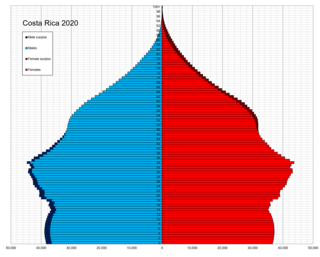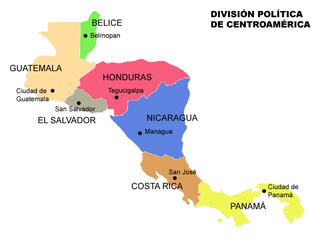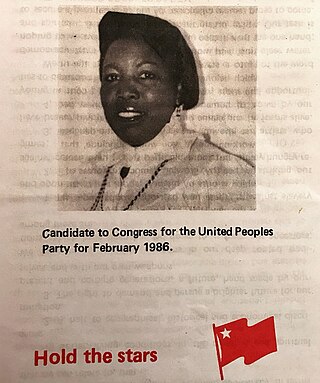
This is a demographic article about Costa Rica's population, including population density, ethnicity, education level, health of the populace, economic status, religious affiliations, and other aspects of the population.

Costa Rican culture has been heavily influenced by Spanish culture ever since the Spanish colonization of the Americas including the territory which today forms Costa Rica. Parts of the country have other strong cultural influences, including the Caribbean province of Limón and the Cordillera de Talamanca which are influenced by Jamaican immigrants and indigenous native people, respectively.

Limón is one of seven provinces in Costa Rica. The province covers an area of 9,189 km2, and has a population of 386,862.
Afro–Latin Americans or Black Latin Americans are Latin Americans of full or mainly sub-Saharan African ancestry.
Afro-Trinidadians and Tobagonians are people from Trinidad and Tobago who are of Sub-Saharan African descent, mostly from West Africa. Social interpretations of race in Trinidad and Tobago are often used to dictate who is of West African descent. Mulatto-Creole, Dougla, Blasian, Zambo, Maroon, Pardo, Quadroon, Octoroon or Hexadecaroon (Quintroon) were all racial terms used to measure the amount of West African ancestry someone possessed in Trinidad and Tobago and throughout North American, Latin American and Caribbean history.

Limón, commonly known as Puerto Limón, is a district, the capital city and main hub of Limón Province, as well as of the Limón canton in Costa Rica. It is the seventh largest city in Costa Rica, with a population of over 94,000, and is home to the Afro-Costa Rican community. Part of the community traces its roots to Italian, Jamaican and Chinese laborers who worked on a late nineteenth-century railroad project that connected San José to Puerto Limón. Until 1948, the Costa Rican government did not recognize Afro-Caribbean people as citizens and restricted their movement outside Limón province. As a result of this travel ban, this Afro-Caribbean population became firmly established in the region, which influenced decisions not to move even after it was legally permitted. Nowadays, there is a significant outflow of Limón natives who move to the country's Central Valley in search of better employment and education. The Afro-Caribbean community speaks Spanish and Limonese Creole, a creole of English.
Afro-Caribbean people or African Caribbean are Caribbean people who trace their full or partial ancestry to Africa. The majority of the modern Afro-Caribbean people descend from the Africans taken as slaves to colonial Caribbean via the trans-Atlantic slave trade between the 15th and 19th centuries to work primarily on various sugar plantations and in domestic households. Other names for the ethnic group include Black Caribbean, Afro or Black West Indian or Afro or Black Antillean. The term Afro-Caribbean was not coined by Caribbean people themselves but was first used by European Americans in the late 1960s.
Limonese Creole, also called Limonese, Limón Creole English or Mekatelyu is a dialect of Jamaican Patois, an English-based creole language, spoken in Limón Province on the Caribbean Sea coast of Costa Rica. The number of native speakers is unknown, but 1986 estimates suggests that there are fewer than 60,000 native and second language speakers combined.

Central America is a subregion of the Americas formed by six Latin American countries and one (officially) Anglo-American country, Belize. As an isthmus it connects South America with the remainder of mainland North America, and comprises the following countries : Belize, Guatemala, Honduras, El Salvador, Nicaragua, Costa Rica, and Panama.

Afro-Panamanians are Panamanians of African descent. The population can be mainly broken into two categories: "Afro-Colonials", those descended from slaves brought to Panama during the colonial period; and "Afro-Antilleans", West Indian immigrant descendants with origins in Trinidad, Martinique, Saint Lucia, Guadeloupe, Dominica, Grenada, Haiti, Belize, Barbados, and Jamaica, whose ancestors were brought in to build the Panama Canal.
Historically, Puerto Rico, which is now an unincorporated territory of the U.S., has been dominated by a settler society of religiously and ethnically diverse Europeans, primarily of Spanish descent, and Sub-Saharan Africans. The majority of Puerto Ricans are multi-ethnic, including people of European, African, Asian, Native American, and of mixed-ethnic descent.

An Afro-Guatemalan person is a person who lives in Guatemala, but has African ancestry in their historical and cultural roots. This term intertwines the conquest of America by the Spanish. The Afro-Guatemalan population is not numerous today. Although it is difficult to determine specific figures, it is reported that Afro-Guatemalans represent only between 1% and 2% of the country's population. According to the Council on Hemispheric Affairs. They are of mainly English-speaking West Indian (Antillean) and Garifuna origin. They are found in the Caribbean coast, in Livingston, Puerto Barrios and Santo Tomas. In the 17th century, many enslaved blacks were able to secure for themselves or at least their future children through marriage to free people. Many of these marriages were with Mayans or Europeans, which created a mix between blacks, Mayans and Europeans. This resulted in a significant mestizo population that, over the years, has continued to dilute traces of African ancestry in many cases. Today this can be referred to as Afro-mestizos due to miscegenation.

Afro Salvadorans are Salvadorans of Sub-Saharan African descent. They are the descendants of slaves brought to El Salvador via the Trans-atlantic slave trade during the colonial Spanish era.

Afro-Nicaraguans are Nicaraguans of Sub-Saharan African descent. Five main distinct ethnic groups exist: The Creoles who descend from Anglo-Caribbean countries and many of whom still speak Nicaragua English Creole, the Miskito Sambus descendants of Spanish slaves and indigenous Central Americans who still speak Miskito and/or Miskito Coast Creole, the Garifunas descendants of Zambos expelled from St. Vincent who speak Garifuna, the Rama Cay zambos a subset of the Miskito who speak Rama Cay Creole, and the descendants of those enslaved by the Spanish.

Afro-Hondurans or Black Hondurans are Hondurans of Sub-Saharan African descent. Research by Henry Louis Gates and other sources regards their population to be around 1-2%. They descended from: enslaved Africans by the Spanish, as well as those who were enslaved from the West Indies and identify as Creole peoples, and the Garifuna who descend from exiled zambo Maroons from Saint Vincent. The Creole people were originally from Jamaica and other Caribbean islands, while the Garifuna people were originally from Saint Vincent and the Grenadines. Garifunas arrived in the late seventeen hundreds and the Creole peoples arrived during the eighteen hundreds. About 600,000 Hondurans are of Garífuna descent that are a mix of African and indigenous as of Afro Latin Americans. Honduras has one of the largest African community in Latin America.

Costa Ricans are the citizens of Costa Rica, a multiethnic, Spanish-speaking nation in Central America. Costa Ricans are predominantly Castizos, other ethnic groups people of Indigenous, European, African and Asian descent.
For a history of Afro-Caribbean people in the UK, see British African Caribbean community.

Black Barbadians or Afro-Barbadians are Barbadians of entirely or predominantly African descent.

Maunrice Eulalee Bernard Little, known as Eulalia Bernard, was a Costa Rican writer, poet, activist, politician, diplomat, and educator. She is considered in her country as an icon of the African descent culture. Bernard was the first Afro-Costa Rican woman to be published in her country.













